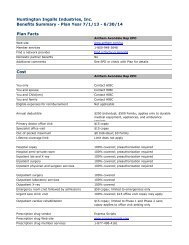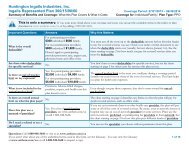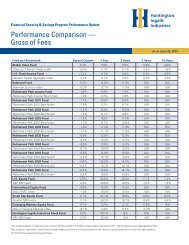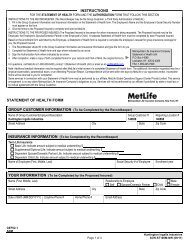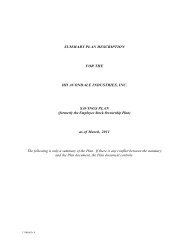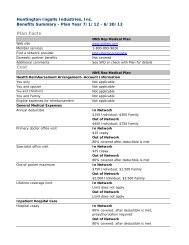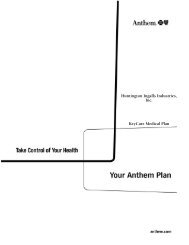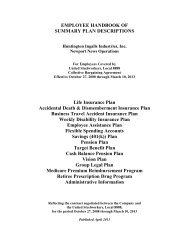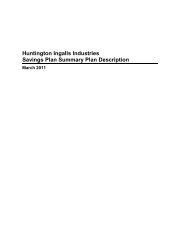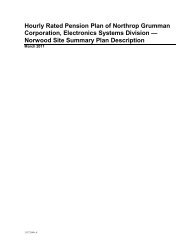AMSEC Employees 401(k) Profit Sharing Plan - Benefits Connect
AMSEC Employees 401(k) Profit Sharing Plan - Benefits Connect
AMSEC Employees 401(k) Profit Sharing Plan - Benefits Connect
Create successful ePaper yourself
Turn your PDF publications into a flip-book with our unique Google optimized e-Paper software.
<strong>Plan</strong> or retirement plans of a similar type) received during the same taxable year by you are treated inthe same manner.An “early” distribution from the <strong>Plan</strong> results in an additional 10% tax on the taxable portion of thedistribution, except to the extent the distribution:(1) Is rolled over to an IRA or other qualified plan, or(2) Is used for deductible medical expenses, or(3) Is distributed on your death or disability, or(4) Is distributed after separation from service and part of a series of substantially equal periodicpayments over your life or the life of you and your beneficiary, or(5) Is distributed to a non-Participant under a qualified domestic relations order, or(6) Is distributed after separation from service, if the separation occurred during or after the calendaryear in which you reached age 55.Generally, distributions made to you before the date you reach age 59½ are considered “early”distributions and subject to additional tax unless one of the exceptions noted above applies. An“early” distribution may be an in-service distribution (i.e., before termination of employment) or adistribution made following termination of employment.If you (or your spouse in the event of your death) receive a distribution from the <strong>Plan</strong> (other thanhardship withdrawals and certain mandatory distributions after age 70½) and wish to defer theimmediate tax on receipt of such distribution, you may transfer (i.e., “roll over”) all or a portion of thedistribution, including the amount of your voluntary non-deductible contributions received in thedistribution, to either an IRA or another eligible retirement plan. To be effective, the “rollover” mustbe completed within 60 days of receipt of the distribution. Alternatively, you (or your spouse) mayrequest a direct rollover from the <strong>Plan</strong> to an IRA or to another eligible retirement plan.If you (or your spouse) do not arrange a direct rollover to an IRA or another eligible retirement plan,you are subject to mandatory federal income tax withholding at a rate of 20% of the taxabledistribution, even if you (or your spouse) later make a rollover within the 60-day period.If you (or your spouse) make a valid “rollover” to an IRA, payment of federal income tax is deferreduntil you (or your spouse) actually begin to receive distributions from the IRA. IRA earningsaccumulate on a tax-deferred basis until actually distributed; however, IRA funds generally may not bewithdrawn without penalty until you (or your spouse) reach age 59½, or, if earlier, you becomedisabled or die. The Internal Revenue Code requires that distributions from a regular (i.e., non-Roth)IRA begin no later than April 1 of the taxable year following the year in which you reach age 70½, atwhich time periodic distributions must begin.The <strong>Plan</strong> is intended to be a qualified “cash or deferred arrangement” under Section <strong>401</strong>(k) of theInternal Revenue Code. If you elect to defer a portion of your compensation and have the employercontribute it to the <strong>Plan</strong> as a <strong>401</strong>(k) deferral, the amounts contributed are not subject to federal incometax when the contribution is made. However, the contribution is subject to Social Security taxes andMarch 201127<strong>AMSEC</strong> SPD




